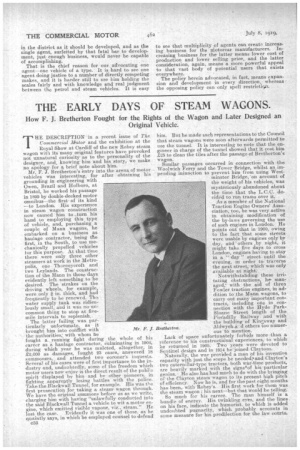THE EARLY DAYS OF STEAM WAGONS.
Page 14

If you've noticed an error in this article please click here to report it so we can fix it.
How F. J. Bretherton Fought for the Rights of the Wagon and Later Designed an
Original Vehicle.
THE DESCRIPTION in a recent issue of The Commercial Motor and the exhibition at the Royal Show at Cardiff of the new Robey steam wagon with its many original features have provoked not unnatural curiosity as to the personality of the designer, and, knowing him and his story, we make no apology for a brief note about him.
Mr. F. J. Bretherton's entry into the arena of motor vehicles was interesting, for after obtaining his grounding in engineering with Owen, Brazil and Holboro, at Bristol, he worked his passage in 1899 by double-decked motor omnibus—the first' of its kind —to London. His experience in steam wagon construction now caused him to .turn his hand to employing this type of vehicle, and, purchasing a couple of Mann wagons, he embarked on a business as haulage contractor, being Cie first, in the South, to use mechanically propelled vehicles or this purpose. At that time there were only three other steamers at work in the Metropolis, one Thorneyeroft and two Leylands. The construction of the Mann in those days evidently left something to be desired. The strakes on the driving wheels, for example, were only in. thick, and had frequently to be renewed. Tho water supply tank was ridiculously small, and it was no uncommon thing to stop at fivemile intervals to replenish.
The latter failing was particularly unfortunate, as it brought him into conflict with the authorities; with whom he fought a running fight during the whole of his career as a haulage contractor, culminating in 1901, during which year he was mulcted, altogether, in £2,000 as damages, fought '23 cases, answered 18 summonses, and attended two coroner's inquests. Several of his cases were of first importance to the industry and, undoubtedly, some of the freedom which motor users now enjoy is the direct result of the publ'e spirit displayed by him and by other pioneers. in fighting apparently losing battles with the police. Take the Blackwall Tunnel, for example. His was the first prosecution for taking a steam wagon through. We have the original summons before us as we write, charging him with having "unlawfully conducted into the said Blackwall Tunnel a vehicle to wit a motor engine, which emitted visible vapour, viz. steam." He lost the case. Evidently it was one Of those, as he quaintly says, in which he employed counsel to defend c33 him. But he made such representations to the Council that steam wagons were soon afterwards permitted to use the tunnel. It is interesting to note that the engineer in charge of the tunnel showed that it cost him X`25 to clean the tiles after the passage of Bretherton's wagon.
Similar passages occurred in connection with -the Woolwich Ferry and the Tower Bridge, whilst an impending injunction to prevent him from using West
minster Bridge, on account of the weight of his vehicles, was mysteriously abandoned about the time that the L.C.C. decided to run trams over it.
As a member of the National Traction Engine Owners' Asso ciation, too, he was very active in obtaining modification of the by-laws governing the use of such engines in London. Ile points out that in 1900, owing to the fact that some streets were usable by engines only by day, and ' others by night, it might take five days to cross
London, engines having to stay in a " day " street until the evening, in order to traverse the next street, which was only available at night.
Notwithstahding these irritating obstructions, heman
aged,with the aid of three
Fowler traction engines, in addition to the Mann wagons, to carry out many importantcon tracts, including one in connection with the Hyde Park Sloane Street length of the Pice"adilly Railway and with
• the building of Kinesway and Alclwych a-d others i!cio numerous to mention.
Lack of space unfortunately forbids more than a reference to his constructional experiences, to which he returned in 1905. Two years were devoted to Sentinel design and in 1914 he joined Claytons. Naturally, the war provided a man of his inventive capacity with just the scope he needed,ftanel. Clayton's two caterpillar-type tractors both war-time products, are heavily marked with the signs of his particular genius. He also has had much to do with the bringing Of' the Clayton steam wagon to its present high pitch of efficiency. Now he is, and for the past eight months has been, with Robey's. His first work for them was the steam wagon ; his next—but that would be telling. So much for his career. The man himself is a bundle of energy. His twinkling eyes, and the lines , on his face, indicate the humorist, to which is added undoubted pugnacity, which probably, accounts in some measure for his predilection for the law courts.






















